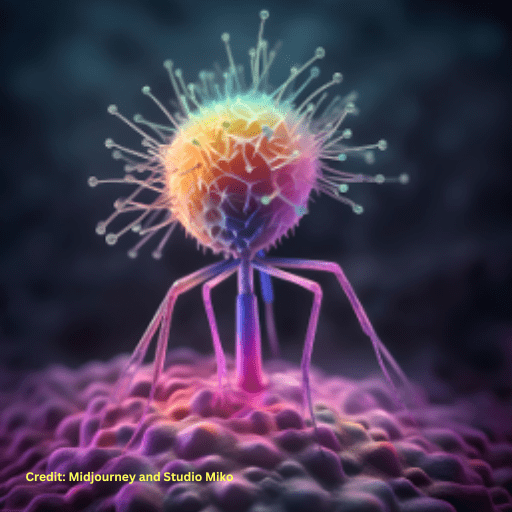This Is The New Top 10 Emerging Technologies Of 2023
Here are the ‘Top 10 Emerging Technologies of 2023,’ which highlight the impact of global connectivity, AI, and the convergence of the physical, digital, and biological worlds. The technologies mentioned include AI in healthcare, flexible batteries for wearable devices, next-generation neural electronics, virtual shared spaces for mental health support, spatial omics for molecular-level understanding, engineered viruses for health augmentation, and the rapid emergence of AI’s potential. However, the societal implications of AI’s capabilities should be considered.
Key Points
- AI is improving healthcare delivery, especially in under-resourced areas.
- Flexible batteries and bendable displays power wearable medical devices and sensors.
- Next-generation neural electronics enable safer interactions with millions of cells.
- Virtual shared spaces in the metaverse facilitate global outreach for mental health support.
- Spatial omics is creating molecular-level “cell atlases” to unlock mysteries, while engineered viruses enhance health in humans, animals, and plants.
Here is the ‘Top 10 Emerging Technologies of 2023,’ list for you.
Sustainable Computing

As one of the top emerging technologies of 2023, sustainable computing focuses on designing and implementing net-zero-energy data centers. With data centres currently responsible for approximately 1% of global electricity consumption, their contribution to the environmental crisis cannot be ignored. However, innovative computing solutions are being developed to address this issue.
Through the use of energy-efficiency techniques such as liquid-cooling systems and repurposing excess heat, progress is being made towards sustainable energy use in data centers. These techniques help reduce energy consumption and minimise waste, contributing to a more environmentally responsible approach.
The ultimate goal is to achieve net-zero-energy data centres, which requires further creativity and integration of technologies for electricity generation, storage, and management. By adopting a collaborative and forward-thinking mindset, we can pave the way for a more sustainable future in the realm of computing.
Sustainable Aviation Fuel

Leading the Path to Net-Zero Carbon Aviation
Sustainable Aviation Fuel (SAF) stands as a transformative solution aimed at reshaping the aviation industry’s carbon footprint. As of 2023, aviation’s environmental impact looms large, contributing between 2% and 3% of global emissions. However, SAF emerges as a beacon of hope, demonstrating the potential to steer the aviation sector towards achieving net-zero carbon emissions, a critical target for a sustainable future.
A Crucial Shift for a Greener Sky
Sustainable aviation fuel is a promising alternative to conventional jet fuel, derived from both biological and non-biological resources. By harnessing renewable feedstocks, SAF offers a substantial reduction in greenhouse gas emissions compared to traditional fossil fuels. This innovation is swiftly gaining momentum as a key strategy to combat climate change while preserving the benefits of air travel.
Towards Net-Zero Carbon Emissions by 2050
Acknowledging the urgent need for aviation to reduce its environmental impact, industry stakeholders are aligning their efforts to incorporate SAF into their operations. With the ambitious goal of achieving net-zero carbon emissions by 2050, the aviation sector is investing in SAF research, development, and production on an unprecedented scale.
From Niche to Necessity
Currently, sustainable aviation fuel accounts for a modest fraction of global jet fuel demand, constituting less than 1%. However, the paradigm is shifting rapidly. Collaborative efforts among airlines, aircraft manufacturers, and fuel companies are poised to revolutionise the industry. Plans are underway to establish numerous sustainable fuel production facilities, marking a transformative transition from a niche solution to a mainstream necessity.
Innovation Beyond Limits
Highlighting the sector’s commitment to innovation, the American Society of Testing and Materials (ASTM) has approved nine distinct varieties of sustainable aviation fuel for blending with conventional jet fuel. The journey doesn’t stop there—research and development efforts continue to explore novel versions of SAF, some of which are derived from innovative processes such as capturing CO2 and producing green hydrogen from renewable energy sources.
Sustainable Aviation Fuel’s ascent to prominence in 2023 underscores its potential to redefine the aviation industry’s environmental impact. As technology, investment, and collaboration converge, SAF is leading the charge towards cleaner skies. This innovation encapsulates the spirit of progress that is not only revolutionising aviation but also reaffirming the collective commitment to forging a more sustainable and ecologically balanced future.
GENERATIVE ARTIFICIAL INTELLIGENCE

Unleashing Unprecedented Creativity and Innovation
Generative Artificial Intelligence (AI) has emerged as a game-changer, pushing the boundaries of human creativity and endeavor. As of 2023, Generative AI represents a paradigm shift, harnessing the power of complex algorithms and data-driven patterns to generate novel and original content across various domains.
Unlocking Innovation through Algorithmic Creativity
Generative AI stands as a testament to the remarkable strides in artificial intelligence. It possesses the remarkable ability to create fresh and unique content by deciphering intricate patterns within data, mirroring the cognitive processes of the human brain. Primarily employed in text, code, images, and sound generation, this technology’s potential spans far beyond that, with applications anticipated in domains as diverse as drug design, architecture, and engineering.
From Pixels to Blueprints: A Multifaceted Approach
Generative AI is not confined to any single arena; rather, it is positioned to revolutionise a multitude of industries. Its versatile nature extends its influence from crafting vibrant visual designs to devising intricate blueprints that shape our physical world. As this technology evolves, it promises to disrupt traditional practices by offering innovative solutions that challenge established norms and revolutionise creative thinking.
Balancing Progress with Responsibility
Amid the excitement, the responsible deployment of Generative AI remains paramount. Ethical considerations are imperative to ensure its impact is positive and far-reaching. Efforts to mitigate bias ingrained within AI systems, safeguard copyrights, and respect individual privacy are critical to harnessing its potential for societal benefit. By addressing these concerns, Generative AI can evolve into a tool that amplifies creativity while adhering to ethical principles.
A Catalyst for Creativity and Conventional Wisdom
Generative AI’s inclusion in the top list of emerging technologies in 2023 underscores its transformative potential. With proper oversight, this technology has the capacity to challenge conventions, stimulate innovative thinking, and catalyse advancements across various domains. As society adapts to its capabilities, Generative AI can redefine the boundaries of creativity, unleashing a new era of invention that resonates across industries and resonates with the human spirit of exploration and innovation.
WEARABLE PLANT SENSORS

Catalysing an Agricultural Revolution for Global Food Security
Wearable Plant Sensors stand as a milestone in the pursuit of sustainable food production to nourish an ever-expanding global population. With the United Nations Food and Agriculture Organisation projecting a 70% increase in food production by 2050 to meet these demands, agricultural innovation takes centre stage.
Agricultural Innovation: A Call of the Hour
Addressing the imminent challenge of feeding a burgeoning global populace necessitates revolutionary advancements in agriculture. Recent strides have encompassed sensor-equipped tractors and satellite data for crop monitoring, effectively enhancing farming efficiency. The next evolutionary leap comes in the form of Wearable Plant Sensors—compact devices capable of attaching to crops and tirelessly tracking essential parameters such as temperature, humidity, moisture, and nutrient levels.
Real-time Insights: Nurturing Abundance while Minimising Waste
The potential of Wearable Plant Sensors lies in their ability to provide real-time data, enabling precision agriculture. By gathering continuous insights from the fields, these sensors empower farmers to make informed decisions that optimise crop yields, curtail waste, and bolster resource efficiency. Early disease detection, precise irrigation management, and tailored nutrient application all contribute to maximising agricultural output while minimising environmental impact.
Challenges and Promises
While Wearable Plant Sensors hold the promise of revolutionising crop production and management, certain challenges loom. Ensuring the scalability and affordability of these devices, interoperability with existing agricultural systems, and addressing data privacy concerns are pivotal steps on this transformative journey. Collaborative efforts from technologists, agronomists, and policymakers are essential to overcoming these obstacles and realising the full potential of this technology.
Cultivating a Sustainable Future
Incorporating Wearable Plant Sensors into the top list of emerging technologies for 2023 underscores their potential to reshape the agriculture industry. As innovation converges with necessity, these sensors have the capacity to drive the advancement of sustainable food production. In a world where global food security is a pressing concern, the deployment of this technology offers a glimpse into a future where the fusion of data-driven insights and ecological consciousness cultivates abundance while preserving the planet.
DESIGNER PHAGES

Illuminating the Path to Enhanced Health and Agricultural Vitality
Designer Phages emerge as a transformative force, revolutionising our approach to human, animal, and plant health. These engineered viruses, with their ability to target specific types of bacteria, wield the potential to reshape the world of medicine and agriculture through precise microbiome manipulation.
Unleashing Microbiome Engineering
Designer Phages represents a groundbreaking leap in biotechnology by exploiting viruses that selectively attack particular bacteria. By harnessing sophisticated laboratory techniques, synthetic biologists can meticulously reprogram these phages. The result is the ability to precisely target individual bacterial species within the complex ecosystem of the human microbiome. Through this strategic manipulation, bacteria can be coaxed into producing therapeutic molecules or rendered sensitive to specific drugs, paving the way for novel approaches to disease treatment.
Healing and Enhancing Across Domains
The application of “designer” phages extends beyond human health, encompassing agriculture as well. By leveraging these engineered viruses, agricultural researchers can optimise plant and animal health, thus boosting productivity. These phages hold the potential to revolutionise disease management strategies in agriculture, reducing the need for conventional antibiotics and pesticides.
Venturing into Promising Realms
The promise of Designer Phages is not just theoretical; it’s backed by compelling early research results that have caught the attention of investors. Substantial venture capital investment is being channelled into the clinical testing of engineered phages. This injection of funding underscores the potential of designer phages to transform medical and agricultural practices, offering new avenues for addressing the challenges of disease and enhancing overall well-being.
A Future Redefined by Precision
Incorporating Designer Phages into the top list of emerging technologies for 2023 highlights their extraordinary potential. As we traverse the precipice of a new era in biology, these viruses stand as beacons of precision and innovation. By wielding the power to engineer microbial communities at will, Designer Phages could catalyse a paradigm shift in healthcare and agriculture, reshaping our approach to human, animal, and plant well-being. This technology epitomises the remarkable convergence of science and practicality, offering glimpses into a future where precision and adaptation work in harmony to foster thriving ecosystems and healthier lives.
FLEXIBLE BATTERIES

Pioneering the Power Revolution for Wearable Technologies
Flexible Batteries emerge as a groundbreaking force, reshaping the way we power wearable devices. These lightweight and adaptable energy sources are igniting a revolution in wearable healthcare devices, e-textiles, and beyond, cementing their place among the top technological innovations.
Bending Possibilities, Powering Innovations
Flexible Batteries epitomise the fusion of form and function. Crafted from lightweight, pliable materials, they have rapidly gained prominence across a spectrum of applications. From wearable medical devices that monitor health parameters to smartwatches, e-textiles, and beyond, these batteries empower innovation by powering technologies that seamlessly integrate with our lives.
Versatile Energy on Demand
The true marvel of Flexible Batteries lies in their ability to bend, twist, and stretch without compromising their energy storage capabilities. Relying on lithium-ion or zinc-carbon systems, these rechargeable batteries deliver dependable power while adapting to the contours of wearable devices and textiles. This adaptability opens up new dimensions for design, enabling devices that fit comfortably and unobtrusively into our lives.
A Thriving Market and Uncharted Frontiers
The global surge in demand for wearable technologies is propelling the flexible-battery market into rapid expansion. These batteries are not only addressing the needs of wearables but also catering to the increasing desire for miniaturisation and elasticity in various applications. As companies pioneer and commercialise related technology, the potential for innovation in flexible battery design and performance remains immense.
Empowering a Connected Future
The inclusion of Flexible Batteries in the top list of emerging technologies for 2023 underscores their transformative potential. As the demand for wearable devices and integrated electronics continues to surge, these batteries become the cornerstone of a more connected and convenient future. With the ability to blend seamlessly into our daily lives, Flexible Batteries exemplify the harmony between human-centric design and cutting-edge technology, heralding an era where power follows our every move, flexing to fit our aspirations and needs.
ARTIFICIAL INTELLIGENCE-FACILITATED HEALTHCARE

Transforming Efficiency in a Rapidly Changing Landscape
Artificial Intelligence-Facilitated Healthcare stands as a beacon of hope and innovation, poised to reshape the efficiency and efficacy of healthcare systems worldwide. The urgency sparked by the COVID-19 pandemic has catalysed the integration of artificial intelligence (AI) and machine learning (ML) into healthcare, creating a paradigm shift with far-reaching implications.
Navigating Crisis and Beyond
The global pandemic highlighted the vulnerabilities of healthcare systems across the globe. This pivotal moment accelerated the incorporation of AI and ML into healthcare, harnessing predictive insights to anticipate and effectively respond to future health crises. By leveraging data-driven decision-making, these technologies promise to expedite medical care, reduce wait times, and optimise resource allocation, thereby creating resilient healthcare infrastructures capable of weathering unforeseen challenges.
Empowering Developing Nations
The potential impact of AI-facilitated healthcare is particularly profound in developing countries, where healthcare systems often grapple with inadequacies. These technologies offer a lifeline by bridging gaps in access to medical expertise, diagnostics, and treatment planning. As AI algorithms evolve, they can significantly enhance healthcare delivery in regions that need it most, ushering in an era of improved health outcomes and enhanced well-being.
Unveiling Challenges and Nurturing Ethics
The transformative promise of AI-facilitated healthcare is accompanied by critical challenges. Ensuring data privacy, managing levels of public acceptance, and fostering patient compliance are pivotal concerns. The ethical underpinning of these systems, given their access to vast volumes of personal data, demands meticulous attention. Crafting a robust ethical framework, buttressed by responsible AI governance, will be imperative to ensure that these technologies yield benefits without compromising individual rights and privacy.
A Vision of Transformative Progress
Incorporating AI-Facilitated Healthcare into the top list of emerging technologies for 2023 underscores its capacity to redefine the healthcare industry. The convergence of AI and healthcare offers a transformative journey, promising precision-driven diagnostics, personalised treatment plans, and efficient health management. As AI continues to shape healthcare, it carries the potential to create equitable healthcare access, expedite medical breakthroughs, and safeguard public health. In embracing AI’s potential, we navigate a future where technology is harnessed as a force for human well-being and resilience, steering the trajectory of healthcare towards efficiency, inclusivity, and unparalleled progress.
METAVERSE FOR MENTAL HEALTH

Negotiating Virtual Spaces for Well-Being
In the dynamic realm of emerging technologies in 2023, the concept of a “Metaverse for Mental Health” emerges as a transformative force, offering a novel approach to addressing the global rise in mental health challenges. As reported by the World Health Organization, the prevalence of mental health conditions and substance use disorders has been on the rise. The COVID-19 pandemic further exacerbated this issue, underscoring the need for innovative solutions.
A Response to Growing Mental Health Concerns
The global surge in mental health conditions calls for inventive approaches. The responsible utilisation of virtual shared spaces within the metaverse offers a unique avenue. Screen time and excessive social media use have raised concerns about psychological well-being, but the metaverse, as a distinct immersive layer of the internet, shows potential to counterbalance these negative effects and actually contribute positively to mental health.
Immersive Well-Being
The metaverse provides an immersive platform that can support various facets of mental health care. By offering shared virtual spaces that are designed to promote relaxation, mindfulness, and social interaction, individuals can find solace, connect with peers, and seek refuge from the stressors of the physical world. These spaces can transcend geographical boundaries and facilitate group therapy, self-help sessions, and other forms of mental health support.
Innovative Treatment Avenues
Beyond providing virtual sanctuaries, the metaverse is also being explored for more active therapeutic purposes. Gaming platforms and non-invasive technologies, such as electrode-containing headsets, are emerging as potential tools for treatment. These technologies harness the immersive and interactive nature of the metaverse to engage users in therapeutic activities, cognitive exercises, and personalised interventions.
A Vision of Hope and Healing
Incorporating the “Metaverse for Mental Health” into the top list of emerging technologies for 2023 accentuates its profound potential. As society grapples with escalating mental health concerns, the metaverse emerges as a digital refuge offering respite and empowerment. By fostering connections, delivering innovative treatments, and crafting immersive experiences, the metaverse embodies a future where technology transforms into a beacon of hope, alleviating the burden of mental health challenges and promoting well-being in an increasingly interconnected world.
SPATIAL OMICS

Unveiling Life’s Intricacies Through Molecular Mapping
Spatial Omics stands as a revolutionary force, poised to unlock the enigmas of life through unprecedented molecular-level insights. This innovative approach marries advanced imaging techniques with DNA sequencing, paving the way for an intricate understanding of biological processes that were once beyond human observation.
Highlighting the Unseen Realm
Spatial Omics empowers researchers to peer into the molecular intricacies of life with unparalleled clarity. By merging cutting-edge imaging methods with DNA sequencing, this technique enables the visualisation of cell architectures and biological occurrences that were once concealed from the human gaze. This transformative capability promises to shape the development of “cell atlases,” intricate molecular maps of diverse species, opening avenues for novel discoveries across the biological spectrum.
A Catalyst for Breakthroughs
The potential of Spatial Omics extends across diverse domains. By delving into the depths of cellular interactions and genetic expressions, it has the capacity to revolutionise therapeutic exploration, illuminate the intricacies of tumour development, and deepen our comprehension of infectious diseases. These insights, hitherto unattainable, could drive therapeutic advancements and lead to more targeted interventions.
Market Momentum and Technical Hurdles
The momentum behind Spatial Omics solutions is growing, marking a promising trajectory for its application. However, technical challenges demand attention. Efficient data acquisition, processing, storage, and standardised reporting are crucial facets that require resolution to unlock the full potential of this technology. Overcoming these hurdles is pivotal for realising the transformative potential of Spatial Omics.
A Paradigm Shift in Biological Understanding
By incorporating Spatial Omics into the top list of emerging technologies for 2023, we highlight its transformative impact on life sciences. This technique holds the power to reconfigure our understanding of biological systems, unveiling mysteries that have eluded us for generations. As the veil is lifted on cellular complexities and molecular dynamics, Spatial Omics may redefine the boundaries of human knowledge, ushering in an era where life’s intricacies are illuminated, leading to breakthroughs that enhance human health, understanding, and the very fabric of existence.
FLEXIBLE NEURAL ELECTRONICS

Bridging Minds and Machines with Precision
Flexible Neural Electronics emerge as a trailblazing force, poised to revolutionise the intersection of the human nervous system and advanced electronics. This groundbreaking approach holds the promise to enhance brain-machine interfaces (BMIs) through ingeniously engineered circuits that seamlessly interface with the intricacies of the brain.
Transforming Brain-Machine Interfaces
Brain-machine interfaces, designed to capture and interpret electrical signals from the brain, are already shaping medical treatments and prosthetic devices. However, conventional probes often fall short, causing discomfort and yielding imprecise readings. A recent breakthrough comes in the form of flexible BMIs that mould to the brain’s contours, significantly improving both comfort and signal accuracy.
Unveiling Neurological Mysteries
Flexible Neural Electronics transcend medical innovation by offering a deeper comprehension of brain diseases. The intricacy and precision of these devices could unravel the complexities of neurological disorders, paving the way for innovative therapeutic interventions. From fine-tuned prosthetics to brain-monitoring devices and even advanced brain stents, the potential applications of these flexible BMIs are vast.
Towards a Human-Artificial Intelligence Nexus
The journey ahead for Flexible Neural Electronics holds the promise of a true marriage between humans and artificial intelligence. As these interfaces evolve, the prospects of achieving seamless interaction between human minds and machines become increasingly conceivable. The road to this future, however, requires careful navigation of ethical considerations, ensuring that the integration of technology into cognition is balanced with the preservation of human agency and dignity.
A Vision of Synthesised Potential
Incorporating Flexible Neural Electronics into the top list of emerging technologies for 2023 spotlights its transformative potential. As we stand on the threshold of a new era, the synergy between neural systems and advanced electronics takes centre stage. Flexible Neural Electronics embodies a profound collaboration between innovation and biology, reflecting a future where minds and machines harmoniously converge, where diseases are conquered, and where the interface between human and artificial intelligence holds promise and possibility, carefully guided by ethical wisdom and humanity’s quest for knowledge.
The world is changing at a rapid pace, and so are the technologies. Sometimes the technologies outpace the ever-changing world dynamics. I hope all these are put to good use by mankind and for this planet. Somewhere, I would like to be optimistic about it, and I’m hopeful as it looks quite promising.





Great info. Lucky me I discovered your site by accident (stumbleupon). I’ve bookmarked it for later!